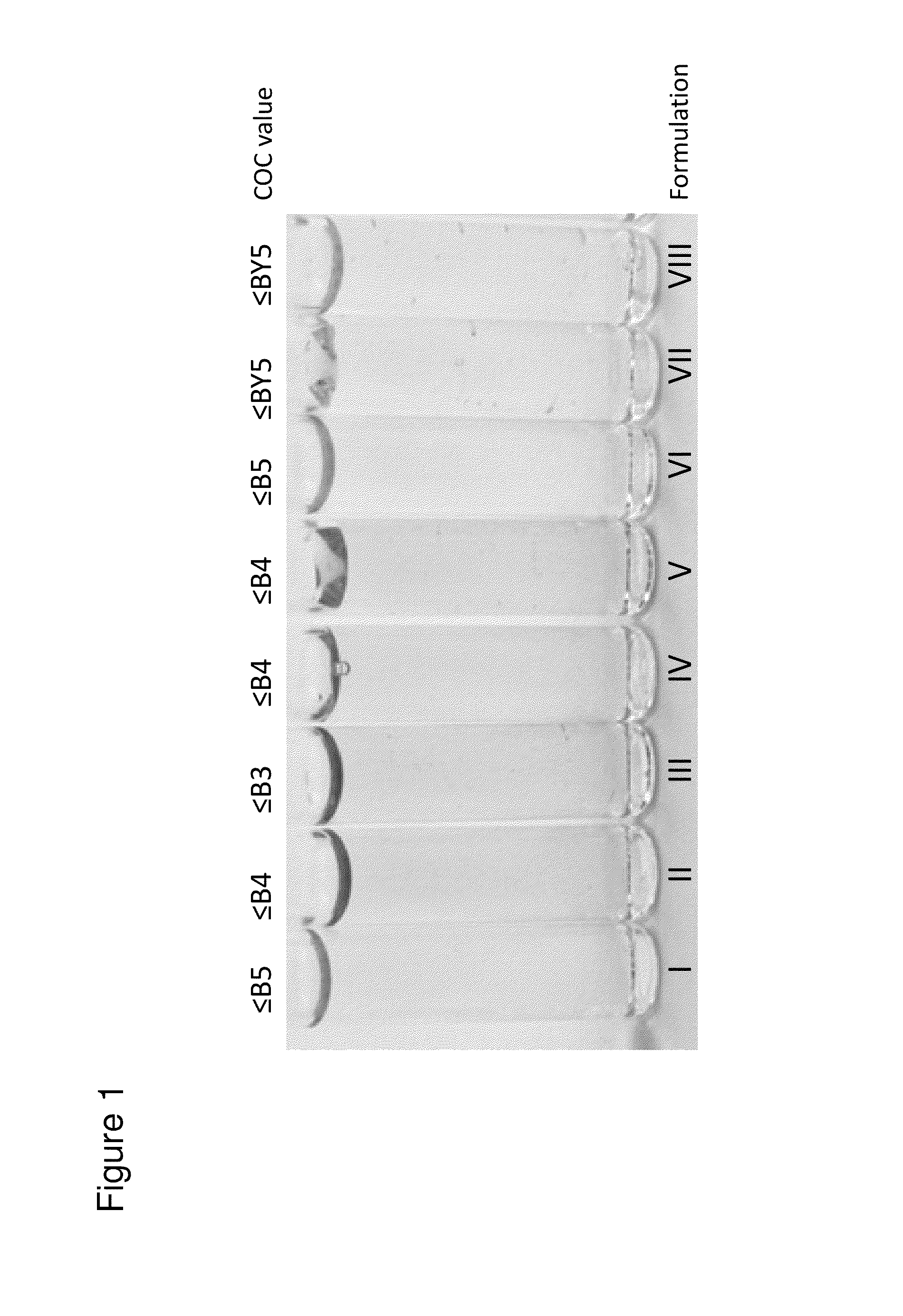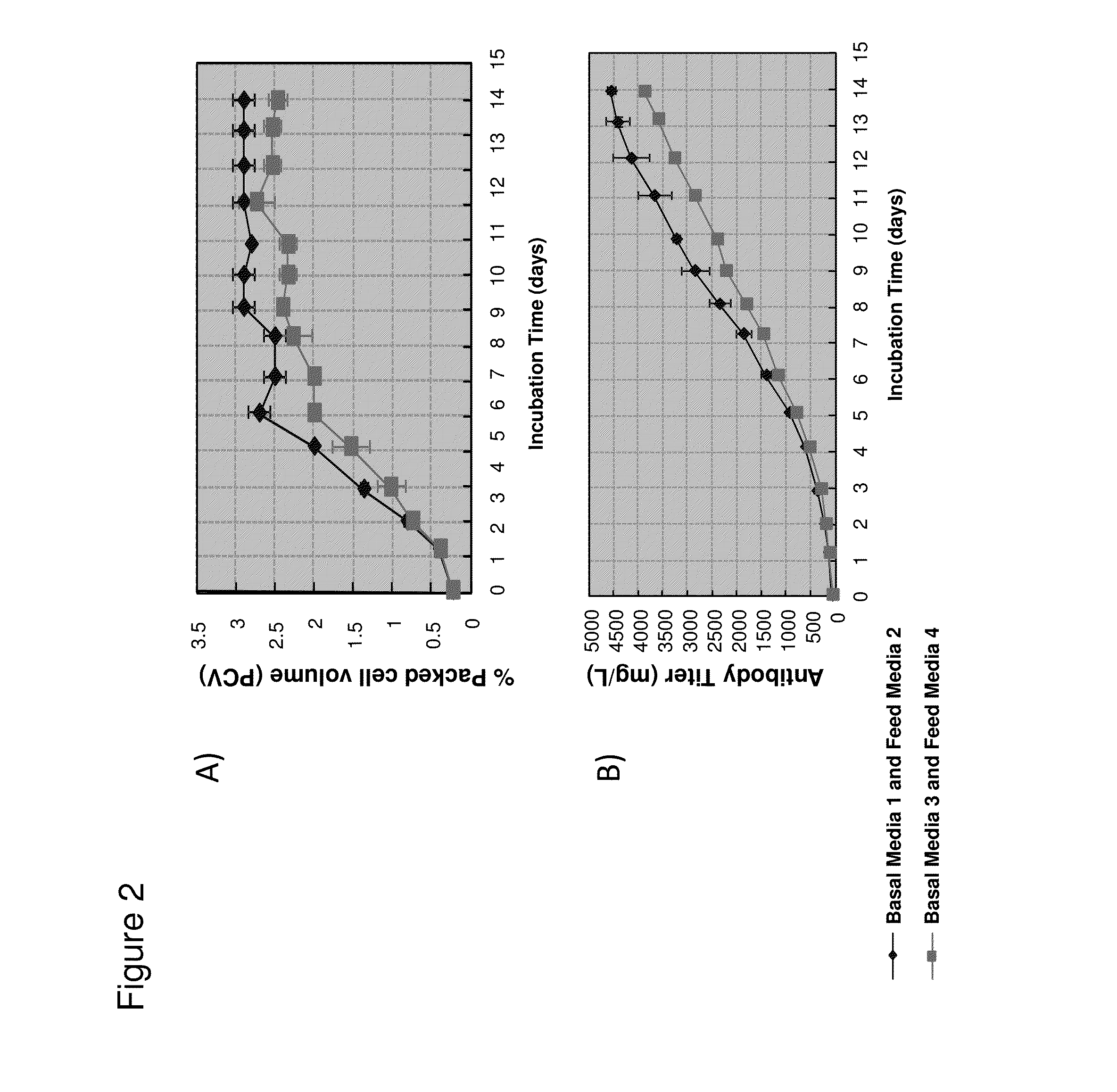Cell culture compositions and methods for polypeptide production
- Summary
- Abstract
- Description
- Claims
- Application Information
AI Technical Summary
Benefits of technology
Problems solved by technology
Method used
Image
Examples
example 1
Color Intensity Exhibited in Formulations Containing Antibody Isolated from Antibody-Producing Cell Lines
[0327]A CHO cell line capable of producing an IgG1 monoclonal antibody (anti-Beta7) was cultured in peptone containing chemically undefined media. The isolated antibody was purified and assayed for color using the standard Clarity, Opalescence and Coloration (COC) assay (Council of Europe. European Pharmacopoeia., 2008, 7th Ed., p. 22). Briefly, the COC assay was performed by using identical tubes of colorless, transparent, neutral glass with a flat base and an internal diameter of 15 mm to 25 mm. A tube was filled up to a depth of 40 mm with a 150 g / L protein solution prepared from purified and concentrated cell culture fluid containing the secreted IgG1 monoclonal antibody. The tube containing the antibody solution was compared to nine reference tubes, each filled with a reference solution ranging from B1 (darkest) to B9 (lightest), by viewing vertically against a white backgro...
example 2
Color Intensity of Antibodies Isolated from Antibody-Producing Cell Lines is Reduced by Alteration of Specific Components in Cell Culture Media
[0329]Basal Media 1 and feed Media 2 were reformulated to contain decreased concentrations of several nutrients for use in cell culture experiments to determine if the reformulated media could reduce color intensity of the isolated monoclonal IgG1 antibody (anti-Beta7) produced by the CHO cell line. Briefly, basal CDM (Media 3) and feed CDM (Media 4) solutions were prepared by combining the components into a single custom formulated blended powder that was dissolved in water and adjusted to a final pH and osmolality that ensured optimal cell growth. Basal Media 3 and feed Media 4 each had an excess of 20 components with components of interest listed in Table B. Some media components such as glucose were not combined into the blended powder but added separately during media preparation. Similarly, media components that were varied for this stu...
example 3
Color Intensity of Antibodies Isolated from Antibody-Producing Cell Lines is Reduced by Alteration of Vitamin B Levels in Cell Culture Media
[0332]To determine the influence of components that were varied in basal Media 3 and feed Media 4 on color intensity of isolated antibody, the levels of vitamin B2, B6, B9, and B12 were varied while the other media component levels were kept constant. The media was prepared as described in Example 2. The media components that were varied for this study were not included in the blended powders but added separately at appropriate levels during media preparation. Basal Media 5 was formulated to have reduced vitamin levels similar to basal Media 3 and all other components similar to basal Media 1 (Table C). For production of monoclonal IgG1 antibody (anti-Beta7) from CHO cells, the cell culture was fed with basal Media 5 for the initial growth phase and at day 3, 6, and 9 cultured with feed Media 2 or feed Media 4. Cell viability measurements and is...
PUM
| Property | Measurement | Unit |
|---|---|---|
| Molar density | aaaaa | aaaaa |
| Molar density | aaaaa | aaaaa |
| Molar density | aaaaa | aaaaa |
Abstract
Description
Claims
Application Information
 Login to View More
Login to View More - R&D
- Intellectual Property
- Life Sciences
- Materials
- Tech Scout
- Unparalleled Data Quality
- Higher Quality Content
- 60% Fewer Hallucinations
Browse by: Latest US Patents, China's latest patents, Technical Efficacy Thesaurus, Application Domain, Technology Topic, Popular Technical Reports.
© 2025 PatSnap. All rights reserved.Legal|Privacy policy|Modern Slavery Act Transparency Statement|Sitemap|About US| Contact US: help@patsnap.com



